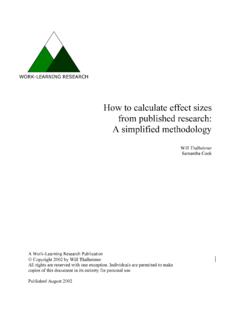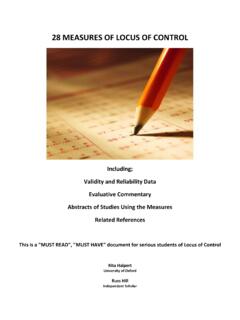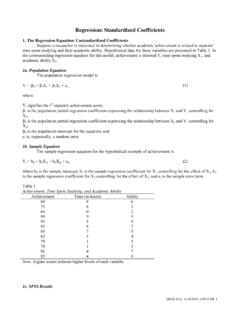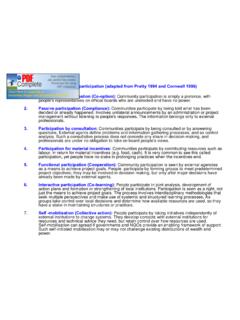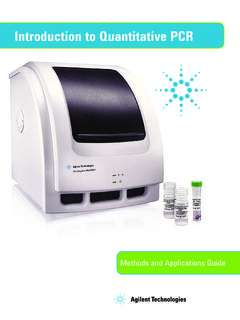Transcription of Quantitative Research Dissertation Chapters ... - B W Griffin
1 1 Quantitative Research Dissertation Chapters 4 and 5 (Suggested Content) Information below is suggested content; seek guidance from committee chair about content of all Chapters in the Dissertation . Brief Review Chapter 3: Method (not Methodology) There is a tendency to report results of sample and measurement information in Chapter 4. However, this information should be reported in Chapter 3. Participants This section contains information on: study setting, how participants were sampled, sample size sought, sample size obtained, response rate, participant demographics, etc. There is no such thing as a sample population. Table 1 below is an example showing demographics of participants. Table 1: Undergraduate Sample Demographics Variable n % Sex Female 162 Male 34 Race African American or Black 35 Asian 3 Multi-racial 6 White 152 Age 18 1 19 46 20 76 21 46 22 10 23 7 24 3 25+ 7 2 Materials, Measurement, Variables Explain how variables were measured including questionnaire/instrument/scale selection or development, item creation or selection, item analysis procedures, item scaling ( , 1 = not true of me to 7 = very true of me ), reverse scored items, etc.
2 Discuss evidence for reliability of scores such as Cronbach s , split-half, KR-20, KR-21 test-retest parallel forms rater/score agreement (Cohen s kappa, Krippendorff s alpha, etc.), and evidence for validity of scores, for example, logical validity: content validity rationale theory, Research , item & sampling validity, expert review empirical validity: construct, predictive, concurrent, structural analysis (factor). Unless your Dissertation focuses on the psychometrics of an instrument, or scale, one should discuss validity and reliability in this sub-section of Method, not in Chapter 4. Chapter 4: Results 1. Opening of Chapter Briefly restate, in a few sentences or a paragraph, the purpose of study, and Research questions and hypotheses. 2. Data Examination, Variable Scoring, and Descriptive Statistics Before presenting results that address your Research questions or hypotheses, first discuss your process of data examination, variable scoring and creation, and then present descriptive statistics.
3 Some of this information is secondary to your study and, if reported, may be better suited for placement in an appendix rather than Chapter 4. Data Examination. Explain to readers the process of reviewing your data for errors or outliers (extreme cases), identifying missing information, and and any corrective steps taken to address errors and missing information. Frequencies. Calculating tables of frequencies can be an excellent first step to identifying problematic data. 3 Example 1: Frequencies. Questionnaire Item: In general, my parents ignore what I have to say: 1 = Not at all 2 = Somewhat 3 = A Moderate Amount 4 = Quite a Bit 5 = Very Much Example 2: Frequencies. Questionnaire Item: What is your race/ethnicity? 1 = American Indian, Alaska Native 2 = Asian 3 = Black or African American 4 = Hawaiian/Pacific Islander 5 = Hispanic/Latino 6 = White 7 = Mixed/Multi-racial Ethnicity Frequency Percent Valid Percent Cumulative Percent Valid 8 "Dark Skin" 1.
4 4 .4 1 1 .4 .4 2 3 2,3,4 1 .4 .4 3 60 4 1 .4 .4 6 169 7 3 7 (6+2) 1 .4 .4 blank 1 .4 .4 Total 249 stemMissingTotalFrequencyPercentValid PercentCumulat iv ePercent 4 Scatterplots. These can be excellent ways to determine problematic data or outliers. Example Scatterplot. What is the relation between Test 2 scores and the average time required to answer each item on Test 2? Pearson r = Very weak, slightly negative relation; the more time one takes to answer each question, the lower will be test scores. How does this relation appear if plotted via a scatterplot? What happens if the suspected cheater is removed from the analysis? Pearson r = Positive weak to moderate relation: the more time on test items, the higher are test scores. Suspected Cheater5060708090100 Percent Correct on Test 250100150200 Average Number of Seconds Required per ItemAmount of Time Required to Answer Each ItemGrade on Test 2 by 5 Variable Scoring and Creation.
5 Explain to readers the process of scoring variables ( use of raw data from responses or convert to scale scores), identification of special scoring procedures ( , items that must be reverse scored), o Formula: Reversed Score = (minimum score) + (maximum score) actual score how missing data or problematic data were addressed, calculation of composite variables ( , summation of raw scores after reverse scoring, mean of items after reverse scoring, etc.), coding of categorical variables ( , dummy or contrast coding for regression), and any special coding needed beyond that described above ( , normalized gain scores). Example 1. This example explains how a scaled variable (ranging from 1 to 5) with a non-scaled response (option 6) was recoded for statistical analysis. To assess instructor reputation, students answered this question: Before taking this course, what did you hear about this instructor? Reponses ranged from (1 very bad to 5 very good , and 6 didn t know about the instructor ).
6 For statistical modeling purposes, responses were recoded into one of three categories: negative reputation (score of 1, 2, or 3; about of respondents), positive reputation (score of 4 or 5; about of respondents), and no reputation (score of 6; about of respondents). 5060708090100 Percent Correct on Test 2120140160180200 Average Number of Seconds Required per ItemFitted valuespercent_correct_test2 Amount of Time Required to Answer Each ItemGrade on Test 2 by 6 Example 2. This example shows how one explains reverse scoring and formation of a composite variable. Perceived autonomy support was measured by student responses to three statements, The instructor was willing to negotiate course requirements with students, Students had very few choices in course requirements or activities that would affect their grade, and The instructor made changes to course requirements or activities as a result of student comments or concerns. The response scale for each item ranged from 1 ( strongly disagree ) to 5 ( Strongly agree ).
7 The second item has reverse polarity from the other two items and was therefore reverse scored. The composite measure of perceived autonomy support was then formed by taking the mean response of the three items. Descriptive Statistics. Present basic descriptive statistics for each variable included in analyses presented in Chapter 4. These may include the following. Categorical, Nominal, qualitative Variables: o category counts/frequencies o category percentages o contingency (cross-classification) tables ( , 2x2 table of sex by test outcome [pass vs fail]) Quantitative , Ordinal, Interval, Ratio Variables: o Central Tendency (mean, median, mode) o Variability (standard deviation, range, variance) o Maximum and minimum scores, maximum and minimum possible scores o Correlations among IV and DVs o Means on DVs across categories of IVs Often such descriptive information is presented with analyses performed to answer Research questions, so a separate presentation of descriptive statistics is not needed in this section.
8 Example 1. Table showing descriptive information for two categorical variables. Questionnaire Item Yes No Do you have daily contact with parents? n % n % 107 89 Is staying in contact with parents the reason for you having the following accounts? n % n % Facebook 58 138 Email 47 139 Instagram 27 13. 8 169 Snapchat 18 177 Google+ 3 186 Pinterest 3 192 Twitter 2 192 99 YouTube 1 191 My Space 1 185 LinkedIn 0 189 100 Tumblr 0 193 100 Yik Yak 0 191 100 7 Example 2. Table showing descriptive information for both qualitative and Quantitative variables. Participate Demographic Information Sex Female N = 1324 ( ) Male N = 1669 ( ) Age Female Mean = years (range = to years) Male Mean = years (range = to years) Source: Suiter, D., & Leder, S. (2007). Clinical Utility of the 3-ounce Water Swallow Test. Dysphagia, 23, 244-250. 3. Statistical Findings List each Research questions/hypothesis, then explain which analysis was conducted to address that question/hypothesis, then present results of the analysis, then move to next Research question/hypothesis.
9 In short, organize results by Research questions and hypotheses. Common Statistical Analyses. Below are the following: Example tables for commonly employed statistical procedures Inferential statements: tells reader whether you rejected or failed to reject the null hypothesis o Significant: means only that the null hypothesis, Ho, was rejected o Significant: does NOT mean something important was found o The correlation between X and Y was statistically significant; found a relation between X and Y o The correlation was not statistically significant; did not find a relation between X and Y Interpretational statements: tells reader, in simple language, what the statistics mean o Pearson r = between academic self-efficacy and test anxiety in mathematics o Simplified: Students who are more confident in their mathematic skills tended to have lower levels of anxiety when taking a mathematics test Correlations. Correlations, specifically Pearson s r, may be used to assess whether a linear relationship exists between two Quantitative variables.
10 A categorical variable with only two categories may also be included as part of a correlational study, although care must be exercised for interpretations. Pearson s r may range from to , with these two extremes representing perfect and very strong relationships, and a value of representing no linear relationship. 8 Table of Correlations. Table 1 below provides an example correlation matrix of results. The data represent students reported levels of anxiety and efficacy toward doctoral study, their graduate GPA, and sex. Table 1. Correlations and Descriptive Statistics for Anxiety and Efficacy Toward Doctoral Study, Graduate GPA, and Sex of Student 1 2 3 4 1. Doctoral Anxiety --- 2. Doctoral Efficacy * --- 3. Graduate GPA * .31* --- 4. Sex .19* --- M SD Scale Min/Max Values 1 to 5 1 to 5 0 to 4 0, 1 Note. Sex coded Male = 1, Female = 0; n = 235. * p < .05. Written Results. For inferential statistical tests, one should provide discussion of inferential findings (was null hypothesis rejected; are results statistically significant), and follow this with interpretation of results.

